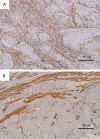Cancer-associated fibroblasts are associated with poor prognosis in esophageal squamous cell carcinoma after surgery
- PMID: 25932118
- PMCID: PMC4402765
Cancer-associated fibroblasts are associated with poor prognosis in esophageal squamous cell carcinoma after surgery
Abstract
Objective: Cancer-associated fibroblasts (CAFs; α-SMA positivity), as a representative of the tumor microenvironment, play an important role in influencing the proliferation, invasion and metastasis of cancer cells. The objective is to investigate the prognostic value of CAFs density in esophageal squamous cell carcinoma (ESCC) after surgery.
Method: A total of 95 patients who underwent esophagectomy for ESCC in 2007 were included in this study. These specimens were immunostained with α-smooth muscle actin (α-SMA) antibodies to quantify CAFs. Antibodies D2-40 and CD34 were used to evaluate the lymphatic vessel density (LVD) and microvessel density (MVD) of the lesions. The Cox proportional hazards model was used to determine the hazard ratio of CAFs density on 3-year overall survival and 3-year disease-free survival. The correlation between CAFs density and lymphatic vessel density (LVD) or microvessel density (MVD) were analyzed.
Results: 3-year overall survival rate in the CAF-poor group (63%) was significantly better than those in the CAF-rich group (42%) (P < 0.01). In the Cox univariate and multivariate analysis of 3-year overall survival, the hazard ratio (HR) of CAFs density was 1.870 (95% CI 1.033-3.385; P = 0.039) and 2.196 (95% CI 1.150-4.193; P = 0.017), respectively. CAFs density was proved to be an independent prognostic factor for 3-year overall survival. CAFs density correlated significantly with increased LVD and MVD in ESCC.
Conclusion: CAFs density may be a marker for predicting prognosis and guiding therapeutic management of ESCC.
Keywords: Esophageal squamous cell carcinoma; cancer-associated fibroblasts; lymphatic vessel density; microvessel density; survival.
Figures






Similar articles
-
Clinical significance of cancer-associated fibroblasts and their correlation with microvessel and lymphatic vessel density in lung adenocarcinoma.J Clin Lab Anal. 2019 May;33(4):e22832. doi: 10.1002/jcla.22832. Epub 2019 Feb 8. J Clin Lab Anal. 2019. PMID: 30737838 Free PMC article.
-
High microvessel and lymphatic vessel density predict poor prognosis in patients with esophageal squamous cell carcinoma.PeerJ. 2024 Sep 27;12:e18080. doi: 10.7717/peerj.18080. eCollection 2024. PeerJ. 2024. PMID: 39351370 Free PMC article.
-
Clinical significance of FAP-α on microvessel and lymphatic vessel density in lung squamous cell carcinoma.J Clin Pathol. 2018 Aug;71(8):721-728. doi: 10.1136/jclinpath-2017-204872. Epub 2018 Mar 20. J Clin Pathol. 2018. PMID: 29559517
-
Cancer-associated fibroblasts: An emerging target against esophageal squamous cell carcinoma.Cancer Lett. 2022 Oct 10;546:215860. doi: 10.1016/j.canlet.2022.215860. Epub 2022 Aug 7. Cancer Lett. 2022. PMID: 35948121 Review.
-
Emerging role of cancer-associated fibroblasts in esophageal squamous cell carcinoma.Pathol Res Pract. 2024 Jan;253:155002. doi: 10.1016/j.prp.2023.155002. Epub 2023 Nov 30. Pathol Res Pract. 2024. PMID: 38056131 Review.
Cited by
-
Clinical significance of cancer-associated fibroblasts and their correlation with microvessel and lymphatic vessel density in lung adenocarcinoma.J Clin Lab Anal. 2019 May;33(4):e22832. doi: 10.1002/jcla.22832. Epub 2019 Feb 8. J Clin Lab Anal. 2019. PMID: 30737838 Free PMC article.
-
The Microenvironment's Role in Mycosis Fungoides and Sézary Syndrome: From Progression to Therapeutic Implications.Cells. 2021 Oct 17;10(10):2780. doi: 10.3390/cells10102780. Cells. 2021. PMID: 34685762 Free PMC article. Review.
-
Esophageal Microenvironment: From Precursor Microenvironment to Premetastatic Niche.Cancer Manag Res. 2020 Jul 16;12:5857-5879. doi: 10.2147/CMAR.S258215. eCollection 2020. Cancer Manag Res. 2020. PMID: 32765088 Free PMC article. Review.
-
Integrating single-cell and bulk RNA sequencing to predict prognosis and immunotherapy response in prostate cancer.Sci Rep. 2023 Sep 20;13(1):15597. doi: 10.1038/s41598-023-42858-9. Sci Rep. 2023. PMID: 37730847 Free PMC article.
-
Cancer-Associated Fibroblast Density, Prognostic Characteristics, and Recurrence in Head and Neck Squamous Cell Carcinoma: A Meta-Analysis.Front Oncol. 2020 Nov 27;10:565306. doi: 10.3389/fonc.2020.565306. eCollection 2020. Front Oncol. 2020. PMID: 33330034 Free PMC article.
References
-
- Jemal A, Bray F, Center MM, Ferlay J, Ward E, Forman D. Global cancer statistics. CA Cancer J Clin. 2011;61:69–90. - PubMed
-
- Feng XS, Yang YT, Gao SG, Ru Y, Wang GP, Zhou B, Wang YF, Zhang PF, Li PY, Liu YX. Prevalence and age, gender and geographical area distribution of esophageal squamous cell carcinomas in North China from 1985 to 2006. Asian Pac J Cancer Prev. 2014;15:1981–1987. - PubMed
-
- Lorusso G, Ruegg C. The tumor microenvironment and its contribution to tumor evolution toward metastasis. Histochem Cell Biol. 2008;130:1091–1103. - PubMed
-
- Udagawa T, Wood M. Tumor-stromal cell interactions and opportunities for therapeutic intervention. Curr Opin Pharmacol. 2010;10:369–374. - PubMed
LinkOut - more resources
Full Text Sources
